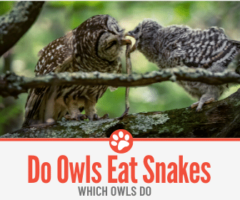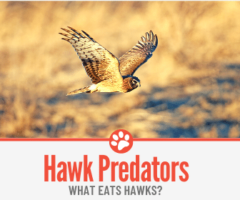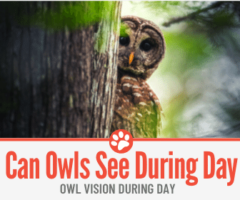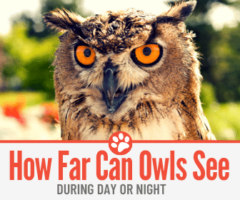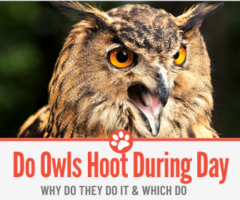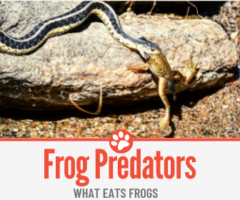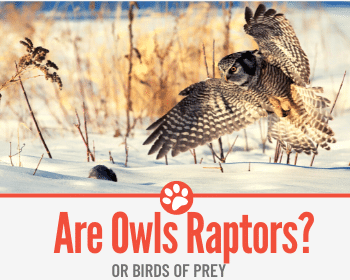 Owls are mystical, magical, mysterious creatures, and we are fortunate enough to have a population of these beautiful birds residing near my home.
Owls are mystical, magical, mysterious creatures, and we are fortunate enough to have a population of these beautiful birds residing near my home.
Recently, we’ve had some clear night skies which have allowed us to see these magnificent birds in action.
While I was watching these majestic creatures, I started thinking about whether it was accurate to label an owl as a raptor? So, I did some research.
Are owls, raptors?
Owls are not considered raptors and they do not make up part of the raptor family as they are part of a distinct order. The key distinguishing factor between raptors and owls is the time of the day at which they are active, owls are active at night-time (nocturnal) and raptors are active during the day (diurnal).
Are owls birds of prey?
Birds of prey, according to the Encyclopedia Britannica are classified in two orders; Falconfirmes (raptors) and Strigiformes (nocturnal birds of prey, owls). Owls can then be categorised into two further classes: Tytonidae (barn owls) and Strigidae (true owls). So, in short, an owl would be considered a bird of prey but not a raptor.
What is a raptor bird?
The word raptor is derived from the Latin word ‘raptare’ meaning “to seize and carry off”. Raptors generally include (hawks, eagles, falcons and vultures).
The crucial difference between owls and raptors is the time of day that they are active, for owls, this is the night-time as they are nocturnal, in other words, they do the “night-shift” for their raptor cousins, who are generally diurnal (active during the day-time).
Why are owls called raptors, and what does not make an owl a raptor?
The terms owl and raptor have become conflated in everyday speech as owls and raptors possess many similar traits. Therefore, owls are often called raptors even though this is not strictly correct.
Owls ability to hunt at night is their key distinguishing factor. Owls have evolved to ensure that they are “best in class” when it comes to night-time hunting, we’ve detailed some of these unique features below.
Owls’ eyes are positioned on the front of their face, meaning that they can take advantage of binocular-like vision, this is different to the majority of raptors who have eyes on the side of their heads.
Owls’ eyes are very large, much bigger than their raptor cousins, and they are elongated, and barrel-shaped with a concentration of rods allowing maximum light to penetrate the eye. The shape and size of an owls’ eyes are perfectly designed for hunting at night, therefore meaning that owls are able to see prey despite the surrounding darkness.
Raptors, on the other hand, do not have the advantage of excellent night-vision.
They do, however, have highly attuned full-colour sharp vision which provides them with excellent depth perception and therefore allows them to easily spot moving objects.
Due to the position of an owl’s eyes, owls are not able to look to their left and right, but this isn’t going to stop the well-adjusted owls from being able to see everything around them.
Owls can turn their heads 270 degrees rather than the more limited turning circle of the raptors, at a mere 180 degrees. Owls, therefore, do not have the problem that most other raptors have of reduced vision when looking to their left or right.

An owls’ head have not only been adapted to increase vision but also to improve their ability to hear. Owls ears are not positioned symmetrically on either side of their heads, one is in fact higher than the other.
The reason for this asymmetricity is to allow owls to triangulate sound in order that they can more accurately identify where prey and predators are located, as vision is often restricted due to darkness.
Furthermore, an owls’ face is shaped like a bowl to maximise the acoustic-impact and ensure they can get the highest quality sound directly to their ears.
Once an owl has been able to hear and subsequently spy their prey, owls then can swoop down completely silently. An owl has the ability to fly without being heard because their wings are coated in soft feathers which creates fluffy-edges.
The requirement to fly silently is crucial for night hunters as the surroundings that they operate in are generally much quieter than their daytime counterparts. Owls are usually much bulkier than other raptors, and this means that they can catch comparatively heavier prey.
Owls can catch prey that is as much as three times their body weight, but this does also mean that they do not have the ability to soar, as other raptors do, but instead can only fly in shorter bursts.
In the final act of capturing their prey, both owls and raptors use their feet, the manner in which owls use their feet is unique.
Owls generally have a three-talon foot, which they can choose to use in one of two configurations: two in the front and one at the back or alternatively all three in the front.
Owls are able to do this as one of their toes is “hinged” and therefore can be placed in either position. This means that owls can adapt to have the best chance of catching their specific prey.
Why is the owl and raptor population declining, and how can we help?
No precise data regarding the number of owls and raptors that exist in the wild has been or is being collected. There is a consensus, however, as predicated by Yale University, that the global avian populations are declining.
Declining owl numbers can be attributed to several factors. These include road mortality, destruction of woodland habitats, cutting of grasslands, loss of nesting sites, moorland management regimes, COVID control measures and warming temperatures.
There are actions that the general public can take in an attempt to limit the impact on owl populations.
ou can encourage owls to the local area and ensure their safety by taking doing things such as constructing nest boxes, limiting their impact on the environment and choosing to purchase organically or locally grown produce.
Why are birds of prey so crucial to ecosystems?
Birds of prey are considered to be a keystone species. A keystone species is an organism that is crucial to the operation of an ecosystem. There are three types of keystone species: ‘predators, ecosystem engineers and mutualists’.
Owls and raptors, amongst other birds of prey, would be considered predators, and they play an essential role in controlling the number of prey species that exist in an ecosystem.
An abundance of prey species in an ecosystem may result in the decimation of vegetation. Therefore, it is crucial to maintain an optimal number of predators to ensure that there is no undue pressure put on any part of the ecosystem.
Related questions
Where are the best places in the spot birds of prey?
Spotting birds of prey can be a tricky business but watching their majestic, spell-binding flight and seeing the beauty of their fantastic plumage is definitely worth the wait. Where to find birds depends on where you are based, so why don’t you start by contacting your local bird charity.
The Americas:The leading charity supporting bird welfare in the United States is the American Bird Conservatory; further information can be found here.
The United Kingdom: The main charity supporting bird welfare in the United Kingdom is the Royal Society for the Protection of Birds; further information can be found here.

